Fuel Parts & Related
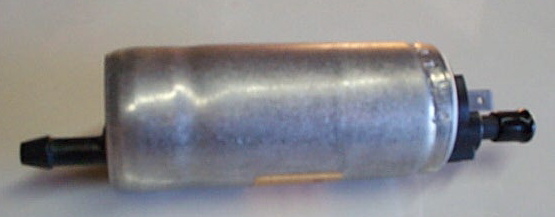
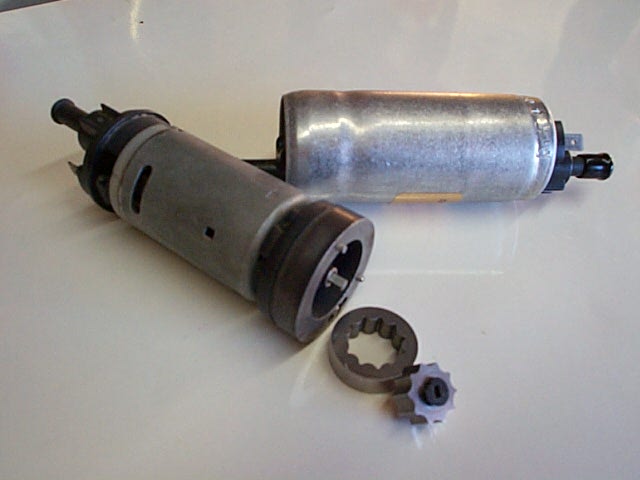
Electric Fuel Pump
Available for both 6 and 12 volt applications. They are gear driven and will pump alcohol and all fuel additives. These fuel pumps overcome vapor lock by increasing the volume of fuel delivered while still maintaining the stock fuel pump pressure. Great Race tested. 6/12 volt electric fuel pumps, comes complete w/30 micron fuel filter, mounting hardware and instructions.
$126.00 each
6-volt - Part #92415EFP6
12-volt - Part #92415EFP12
Installation Instructions: CLICK HERE
- 6-volt output “ two pounds” working pressure - 15 gallons hour fuel delivery
- 12-volt output - "four pounds” working pressure - 30 gallons hour fuel delivery
- This electric fuel pump requires no fuel pressure regulator for most applications

Replacement 30 Micron Fuel Filters
This is the replacement 30 micron fuel filter for the 92415EFP6/12 fuel pump described above. It prevents dirt, rust and refinery sediment from getting into the electric fuel pump. Also works well with any low pressure fuel system application. Great Race proven. Designed for 5/16 inch fuel line installations.
$15.00 each
Part #07415RFF

30 Micron See Thru Fuel Filter
Developed for the Great Race this "see thru" fuel filter is designed to be installed at the carburetor so any contaminants can be easily seen. Filter can be cleaned and replaced easily without tools. Extra filters and hardware also included.
$45.00 each
Part #92502STF
Installation Instructions: CLICK HERE
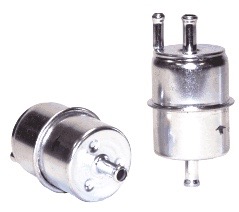
Special Application Dual Outlet Fuel Filter
One thing modern fuel systems do is recirculate the fuel between the tank and the fuel pump. This helps keep the gasoline cool, and keeps the gasoline from turning to vapor and blocking the flow of fresh gasoline to the carburetor (in our case), and any extra volume of gasoline can be returned to the fuel tank. Adding a fuel return line to an antique vehicle fuel system was a difficult job, until now. We make it easy with our dual outlet fuel filter.
Standard 5/16” inlet and outlet with 1/4” outlet for return line.
Want to learn more? Visit Garage Tech.
$15.00 each
Part #17415DOF
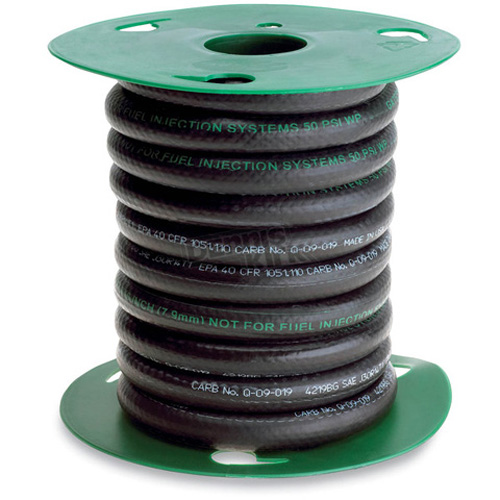
Gates Barrier Fuel Hose
We now offer 25' Rolls of the Gates 5/16" Barrier Fuel Hose as featured in the book "The Official Guide to Modern Gasoline and Oil for Antique Vehicles". Modern alcohol gasoline destroys non-barrier fuel hose (fuel line hose manufactured before 1985) so updating fuel lines is a must. This Gates Barrier fuel hose is a direct replacement suitable for all types of antique vehicles with carburetor type fuel systems.
This is the correct size hose you will need to use with the 92415 EFP and all of the fuel system components we offer. For more information on Barrier type fuel hoses see Randy’s Blog entry on "Barricade Fuel Line Hose...What It Is And Why You Need It..."
$75.00 per 25 ft. Roll
Part #2016415GFL
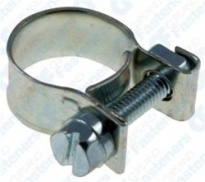
Steel Fuel Line Clamps
We now offer quality steel fuel line clamps that are easy to tighten, seals tight, and holds its shape. These clamps work well with the Gates 5/16 Barrier fuel line hose offered above. Sold ten clamps to a package.
$20.00 Box of 10 Clamps
Part #2016415FHC

Fuel Pressure Regulator
This pressure regulator is set at the factory for 2.7 pounds. It has an infinite adjustment range between 1 and 4 pounds, and is ideal for multiple carburetor(s) and early model vintage car applications. Highly accurate and proven reliable in Great Race applications.
$75.00 each
Part #07415FPR
Installation Instructions: CLICK HERE
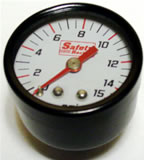
Fuel Pressure Gauge
Designed to be used along with our fuel pressure regulator listed above. Great for multiple carburetor(s) and early model vintage car applications. Eliminates the guesswork when setting up your fuel system, and helps identify fuel delivery problems. Highly accurate and proven reliable in Great Race applications.
$50.00 each
Part #07415FPG
Installation Instructions: CLICK HERE
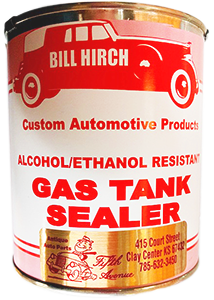
Fuel Tank Liner
All good things must come to an end. So it was with our Line-A-Tank gas tank sealer that we sold for more than twenty years. It is no longer being manufactured. So we found something equally as good and for some applications better. This new sealer has also been manufactured for more than twenty years, and will work on metal aluminum and even fiberglass tanks. It is alcohol resistant. We have researched this product for over a year and it works, plain and simple. One quart will do a twenty-gallon tank and you do not have to use it all at one time. You can use only a portion of the can then if you seal it up well it will be good for the next project. Complete instructions are on the can. Best of all the cost is the same as the old product.
One quart seals up to a 20-gallon tank.
$25.00 per Quart
Part #1603415GTS
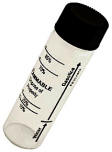
Fuel Tester
Now You Can Check The Percentage Of Alcohol In The Fuel You Buy In Ten Minutes Or Less!
Alcohol In Gasoline – Short Term Effects
As antique vehicle owners we experience first-hand the problems associated with the modern alcohol fuels. Vapor lock, stalling, poor acceleration, and hard starting (caused by the fuel evaporating in the fuel line before the mechanical fuel pump), are all symptoms we are familiar with. The alcohol is also an aggressive solvent that will loosen varnish and gum deposits in the gas tank and fuel system. That will in turn plug fuel filters, and affect the operation of the idle jet, needle and seat, and float in the carburetor.
Alcohol In Gasoline – Long Term Effects
When antique vehicles are placed in long-term storage (6 months or more) the alcohol in the gasoline will draw moisture (up to a gallon a year) from humidity and temperature changes, and thru places like the vented fuel cap. In as little as sixty days the alcohol will begin to separate from the gasoline and the newly formed mixture of alcohol and water will settle in the bottom of the fuel tank where it begins to loosen the rust and corrosion on the inside of the tank. The mixture will also attack welded seams and any thin places in the tank (corners) eventually causing the tank to begin leaking fuel. (The alcohol can also damage rubber fuel lines.)
If the pickup tube of your gas tank is in the bottom of the tank as most antique vehicles are, you will get the alcohol and water mixture instead of the gasoline when you try and start your car after it has been in long -term storage. Testing the gasoline yourself is the only way you will know for sure, the percentage of alcohol in your gasoline.
$24.00 each
Alcohol Fuel Test Kit PT # 12415ATK
For more information on alcohol gasoline and its affects Click and view the following links:
Installation Instructions: CLICK HERE
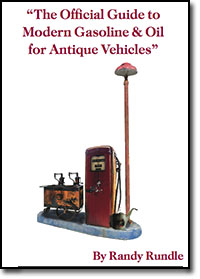
The Official Guide To Modern Gasoline & Oil for Antique Vehicles
Randy has been preparing antique vehicles for what is now the Hemmings Great Race since 1989. In this 60 - page book Randy explains how the changes to modern gasoline and engine oil have affected antique vehicles, and what you need to do to protect your antique vehicle from these changes. A must have book for all antique vehicle owners.
Color throughout. Call 785-632-3450 or use our online order form to order your copy today.
$18.00 post paid

Zinc Replacement Additive
In 2004 the zinc additive that has been in motor oil since the 1930's quietly disappeared. (Click here to learn why) Engines built with a flat tappet valve train need the zinc additive to prevent excessive internal engine wear. Now you can add it back. See chart in installation instructions.
$22.00 bottle (16 oz.)(USA Made)
Case of 12 bottles - $200.00
Part #10415ZA
Fifth Avenue Facts
Randy designed and built the first 6-volt alternator in 1987. Up to that point there was no such thing as a 6-volt alternator, only modern 12-volt alternators were available.

